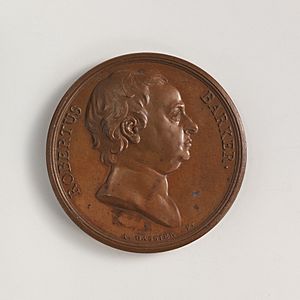Robert Barker (physician) facts for kids

Robert Barker (died 1745) was a British doctor and a clever inventor. He was a Fellow of the Royal Society starting in 1732. This means he was part of a very important group of scientists.
Barker invented a special type of reflecting microscope in 1736. He also created something called "Barker's Mill" in 1743. This mill was an early version of a reaction turbine, which is a machine that spins using the force of water. Robert Barker passed away in London on September 9, 1745.
Understanding Barker's Mill: A Water-Powered Spinner
Barker's Mill is a device that spins around using the power of water. It works thanks to Newton's Third Law of Motion. This law says that for every action, there is an equal and opposite reaction. In the mill, water shoots out, and the reaction pushes the mill to spin.
Dr. Robert Barker is given credit for inventing this mill in 1743. A scientist named John Theophilus Desaguliers wrote about it in his book Experimental Philosophy in 1744. Desaguliers even showed the mill to the Royal Society. Sometimes, Barker's Mill is called tourniquet hydraulique in French, which means "hydraulic turnstile."
How Barker's Mill Inspired New Inventions
Barker's Mill was a really important idea that led to many other inventions. Here's how it developed over time:
- 1750: Johann Andreas Segner created a practical version of the idea called the Segner wheel. This was a big step in making the mill useful.
- 1754: Leonhard Euler, another famous scientist, improved Segner's idea with his own design, sometimes called the Euler wheel.
- 1767: A lecturer named James Ferguson showed off a model of Dr. Barker's water mill.
- Around 1790: James Rumsey found a way to make Barker's mill work better. His improvements allowed it to spin with less water.
- 1827: The first modern water turbine was invented by Benoît Fourneyron. This showed how much the original idea had grown.
- 1839: James Whitelaw and James Stirrat from Paisley got a patent for a water turbine that was based on Barker's Mill. This shows how Barker's original invention continued to inspire new technology for using water power.

